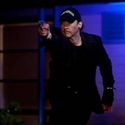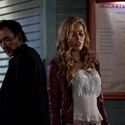MOVIE REVIEW: A Double Feature of Murder, Madness, Mystery and Noir
THE BAG MAN and IN SECRET
March 6, 2014
The Bag Man
This week brings us two delectable works that embrace and celebrate film noir and all the deliciousness of the genre. One, THE BAG MAN, inspired by "The Cat", a work by Jungian scholar Marie-Louse von Franz, is set in present day and filled with slick saturated hyper-realistic color and frenetic yet controlled emotion. The other, IN SECRET, set in 1897 Paris, is based on Emile Zola's scandalously lust-filled novel "Therese Raquin". Both films are filled with murder, guilt, lust and madness, not to mention superlative performances led by John Cusack and Jessica Lange, respectively. Intriguing and engrossing, both are "Must See" films for 2014.
THE BAG MAN
Directed by Dave Grovic and co-written by Grovic and Paul Conway, THE BAG MAN leaps off the screen with color, texture and mystery, captivating us visually and with the performances of, among others, John Cusack, Robert De Niro, Rebecca Da Costa and Crispin Glover. And let me say up front, Cusack and De Niro dazzle with a tete-a-tete dance of character, feeding off each other with a psychological frenzy that is riveting.
Jack is a mysterious man in black. A man of few words, he likes to get in and get out when hired to do a job. His latest assignment is for Dragna, a legendary international crime boss. Jack is to retrieve a bag, go to a motel and wait to make a hand-off. And for that he will be paid handsomely. Simple enough. But there's a caveat. Under no circumstances is he to look in the bag. Do not look in the bag. Do not do it. Do not look in the bag.
Following Dragna's instructions to the letter (or at least trying to), Jack heads out into the middle of nowhere on a dark rainy night. But things are unsettling, unseemingly, as if something is lurking around the corner. Almost with a sixth sense, Jack knows something isn't right. And as he quickly learns, something isn't.
Sequestering himself, per Dragna's instructions, in a rundown motel run by a weird little man in a wheelchair, Jack soon finds the place busier than Grand Central Station. Shady characters start popping up everywhere - Russians, little people, thugs and one strikingly beautiful prostitute named Rivka. And dare I mention some corrupt local cops who can't seem to figure out what side of the law they should be on?
As night drags on, Jack, being a gentleman, finds himself embroiled with Rivka trying to "save" her from various and sundry individuals, all of whom we slowly discover are intricately involved with Dragna and all of whom seem to be looking for the bag. There are games afoot and Jack hasn't been told all of the rules or the players. But everything explodes and truths start to surface when Dragna himself arrives on scene. And while Jack hasn't looked in the bag, it turns out that Rivka did.
John Cusack knocks it out of the park. As Jack, the hitman with a heart of gold, Cusack dives head first into the character, immersing himself in the world of Dragna, delivering passion, confidence, yet Lloyd Dobbler vulnerability and tenderness that makes his patented pointed snarkiness all the more effective. Thanks to Cusack, Jack isn't just a cookie cutter hitman. He has depth, humanity and a moral compass that struggles to find its way. But then you toss Robert De Niro into the mix and into a scene with Cusack and the film explodes with an unseen energy that is palpable.
On first sight of De Niro as Dragna, one is immediately transported to "Wag the dog" and Dustin Hoffman's character. That is the specific physical look of Dragna yet the dialogue and persona is that of De Niro in the same film. Dragna is a physical and emotional blend of De Niro and Hoffman from that film, from poofy hair down to socks and sandals. It works. It dances. It delights. And when it comes to monologues, De Niro kills it thanks not only to his style and panache as Dragna, but thanks to some pop culture infused dialogue that cuts across the grain adding even more blackness to the inherent comedy and tragedy of this murderous night.
Expounding and compounding the story and its dark heart is Crispin Glover who always adds his own element of the absurd and curious to a character. He does so here as motel manager Ned. And again, as Cusack does with De Niro, so it goes with Cusack and Glover. An hysterically gruesome twosome. A dead ringer for Elizabeth Berkeley is Rebecca De Costa. Turning tricks and turning heads as Rivka, Da Costa adds yet another layer of intrigue to the story and with her performance, adds some unspoken texture to the relationship between Rivka and Jack.
Dominic Purcell adds some muscle not only to the story but visually with his Larson. Joining in the fracas and frenzy are some spot on noir caricatures by Sticky Fingaz and Martin Klebba as Lizard and Guano, respectively. Unfortunately for Fingaz and Klebba, although entertaining, the silliness of Lizard and Guano detracts from the dramatic tension almost to the point of distraction.
Ambiguity, double edged swords and mind games are just some of the tools in the Grovic-Conway toolbox with each being used appropriately and effectively. Action is a plenty and well done. The one downfall, however, is the somewhat neatly wrapped ending (although you will find out what's in the bag). The grit of life and murder should never end neatly in a film of this noir nature. Cinematographer Steve Mason delivers an Oscar-worthy lensing with many scenes metaphorically embracing the duality of story and character thanks to well posited and framed mirrors. Creating a glossy, polished palette filled with the telling effects of hazy neon and water, Mason celebrates the inky blue black tones and shadows of night, then countering that with a flood of light and color with the appearance of Dragna at the motel.
Icing on the cake is scoring by Tony Morales and Edward Rogers. With elements and tone of an Ennio Morricone "spaghetti western" score, the music mirrors the man of Jack. Wonderful completing thread to the tapestry.
While you may be told "Do Not Look in the Bag!", you definitely have to take a look at THE BAG MAN.
IN SECRET
One of the beauteous elements of Emile Zola's work is that, when done properly, story adaptations can be transported from one era to another, and in some cases, as with IN SECRET, even blur the genre line to meld temporal lines. IN SECRET does just that. Timeless in story, classic in its telling, shift the setting from 1867 France and England to 20th century 1940's New York or Los Angeles, toss in Barbara Stanwyck and Fred MacMurray instead of Elizabeth Olsen and Oscar Isaac, and you have a perfect noir film. Charlie Bratton's adaptation would be as easily at home with a 20th/21st century setting as 19th century. After all, aren't crimes of passion always in fashion?
A sea traveler by trade, Therese's father has left her in the care of his sister/her aunt, Madame Raquin. The arrangement is perfect as Therese's father is sending money to care for his daughter and Madame has a young son of her own, Camille, who will be a perfect playmate for Therese. Serving as Camille's playmate and essentially a servant to Madame, Therese has a lonely existence, dreaming of the day when her father will return and take her away. But such is not to be as she gets word her has passed away, leaving her alone and now penniless. An orphan, Therese is unfit for any "proper" husband, but Madame has a plan. Therese will marry Camille and the three of them will live together. Camille will earn the money but Therese will still be in servitude.
No longer content to live in the French countryside, the trio move to the City where Camille has taken a job. Money from the sale of their country home is used for Madame to buy a dress shop where Therese will, of course, toil and slave for her mother-in-law. One Thursday night (as this was get together game night), Camille brings home a childhood friend now working at the same company with Camille. Laurent is everything Camille is not. Laurent is strong, sexy, dark haired with piercing dark eyes. He smolders with every look, every movement, every unspoken word. Camille is a foppish, greasy-haired wimpy mama's boy oozing Oedipal tendencies. And he has never sexually satisfied the long repressed Therese. Laurent and Therese have an immediate connection. You can feel the heat rising from the screen it is so intense. It doesn't take long for the two to become embroiled in a passionate affair, ultimately plotting to get rid of Camille so they can leave Madame and run away together.
Needless to say, there is killing, but also remorse, guilt and, aha, no money for Therese and by extension Laurent, as Camille's will left all his holdings to his mother. Where does that leave the young lovers? Under the thumb of Madame Raquin and IN SECRET ensconcing itself in noir driven elements and tone.
Written and directed by Charlie Stratton, IN SECRET embodies the 19th century world while capturing the forward-thinking contemporary mores and emotions of Emile Zola's original novel in what I would describe as one of his most intensely evocative and sexually driven works. As difficult as it is to put down the book, it is equally so to not look at the screen. Characters are rich, full bodied, ready to burst forth with emotional color and depth at every moment. Story engages, intrigues and fascinates. But then there's performance.
Most took note of Oscar Isaac for the first time with "Inside Llewyn Davis". I can't urge you strongly enough to see him here as Laurent. Ladies, his smoldering sexiness will have you drooling and lusting for more. Dark, mysterious, hotter than the hottest sex. Isaac is made for period pieces and seduction.
As Therese, Elizabeth Olsen runs the emotional gamut, drawing you ever deeper into the web of lies and intrigue. A magnificent descent into emotional darkness and guilt that is transformative. seductive controlled emotion explodes. With IN SECRET, Olsen delivers an accomplished level of emotional maturity. And together, she and Isaac are scintillating.
Tom Felton is a buffoon and fop, and perfect at it. As mama's boy Camille, Felton capitalizes on the braggadocios nature and weaknesses of his well known Draco Malfoy character from "Harry Potter" and then pushes it further with a suppressed intentional maliciousness. Brilliantly done.
What can one say about Jessica Lange. Deliciously Oedipal with a malevolent edge. A crowning glory of manipulation. Captivating subtle nuance and texture that sizzles. Lange is rapier, walking the fine line of obsession and a mother's love. Without a doubt, as Madame, Lange delivers one of the best performances of her career.
The meld of production elements with IN SECRET is flawless with each reliant upon and enhancing the other starting with Florian Hoffmeister's cinematography. The first half of the film is as if we are looking at masterpiece paintings celebrating the beauty and light of nature. Capturing the careful apportionment of set pieces as if that in a Vermeer, there is a deliberate beauty to Uli Hanisch's production design that is showcased by Hoffmeister. On moving location to Paris, this is not the beautiful Paris. This is a Paris that is grimy, gritty, dirty. Smoke from coal stoves, oil lamps and candles permeate the air and cover the world with a thin sooty film and is lensed so as to be palpable. Again thanks to Hanisch, the Parisian alley where the Raquins live looks like Harry Potter's Diagon Alley gone bad! (Which is perfect for Felton, not to mention his "Potter" co-star Shirley Henderson who appears here as family friend and busybody Suzanne.) Costumes by Pierre-Yves Gayraud are beautiful with Hoffmeister's lighting and lensing capturing the texture of the fabrications from the watery weave of a moire silk to the heaviness of a mourning broadcloth.
In Secret
Visual tone is fueled with light and shadow, particularly when making use of negative space, never more effective than after Camille's death as does as much to tell the story as the performances. The editing team of Paul Tothill, Celia Haining and Leslie Jones work in tandem with Hoffmeister's eye, using pacing and cutting to capture the lust and emotion of Therese and Laurent. Sunlight warmth with half shadow just fuels the naughty nature of the deed. Metaphor plays heavy with visual tonal bandwidth as life gets darker and grimmer once murder is done while some underwent lensing is magical. A perfect contrast to the underlying darkness of multiple sins.
One shortcoming, however, is a story disconnect, a missing piece. How do we jump so quickly in such a repressed world to the infidelity and hot lust. That's never really sufficiently fleshed out.
There's nothing secret about IN SECRET. It sizzles and satiates.




























Reader Comments(0)